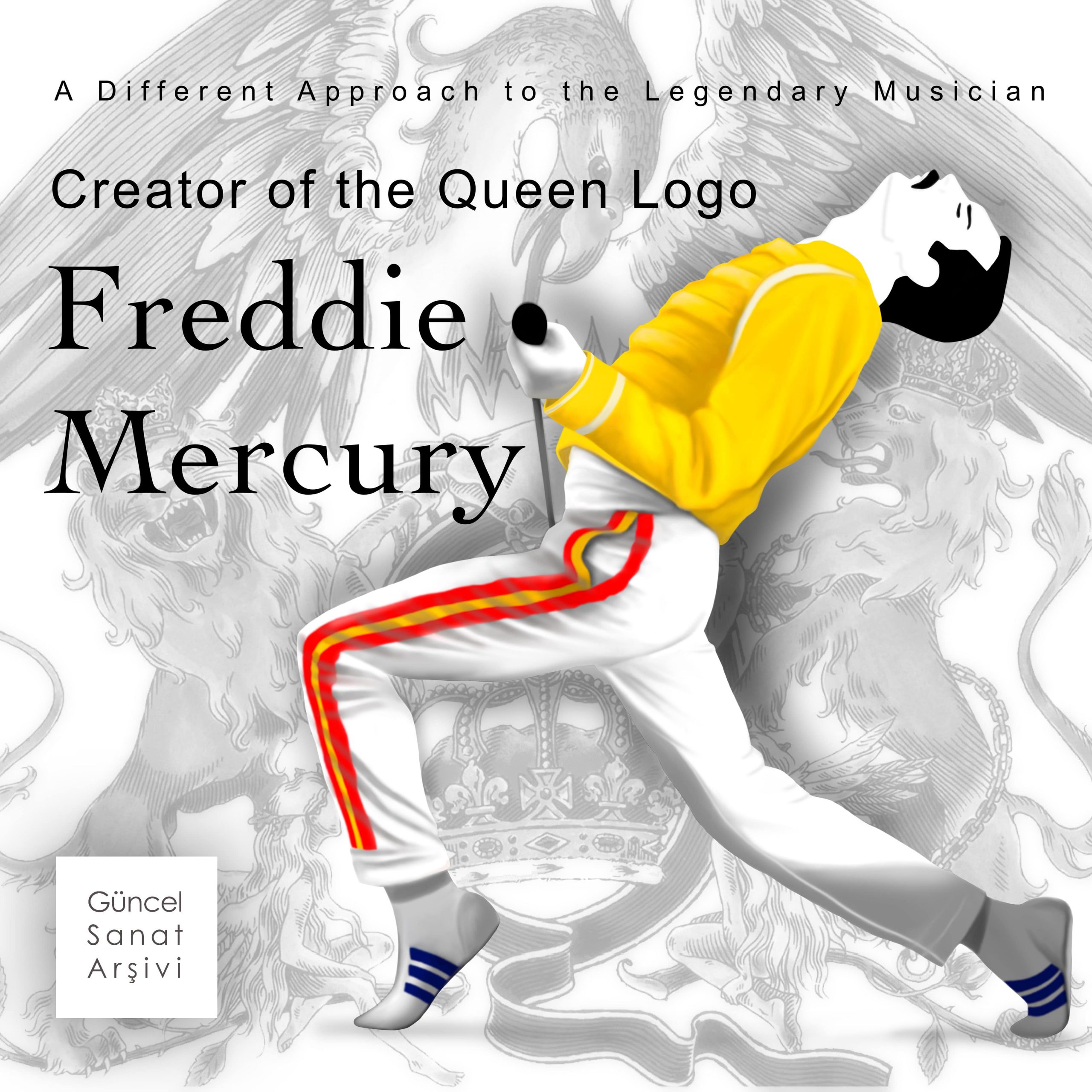Did you know that Freddie Mercury, who is considered one of the biggest rock stars in the world and became a subject of even scientific research with the power of his voice, was also a graphic design graduate and created the logo of the British rock band Queen, of which he is one of the founders? This article aims to offer a different approach to Freddie Mercury by focusing on the Queen logo designed by him, and also pays homage to the legendary musician on the 30th anniversary of his passing.
Burçin Nilay Kalınbayrak

Freddie Mercury performing on the “Queen II” tour at Rainbow Theatre, London, England, 31.03.1974. Photo by Ian Dickson.
A Majestic Voice
Freddie Mercury is a magnificent artist who still manages to attract the attention of the world with his incredible voice, powerful stage performances, unforgettable compositions that move the masses, and musical achievements. An enigmatic musician in the know that he would become not just a star but a legend with his ability to sing and compose in different music genres from heavy metal to jazz, from hard rock to pop, and from blues to disco.
As much as he inspires admiration and respect with the expressiveness and beauty of his voice, he still continues to cause both astonishment and controversy because of his voice’s power and diversity. So much so that, in 2016, some scientists, who set off with an aim to prove the content of complementary definitions about Freddie Mercury’s voice such as “a force of nature with the velocity of a hurricane”,1 made a scientific analysis that justified these definitions, and presented that Freddie Mercury’s vibrato technique and speed are the most important and unique features that distinguish him from others.2
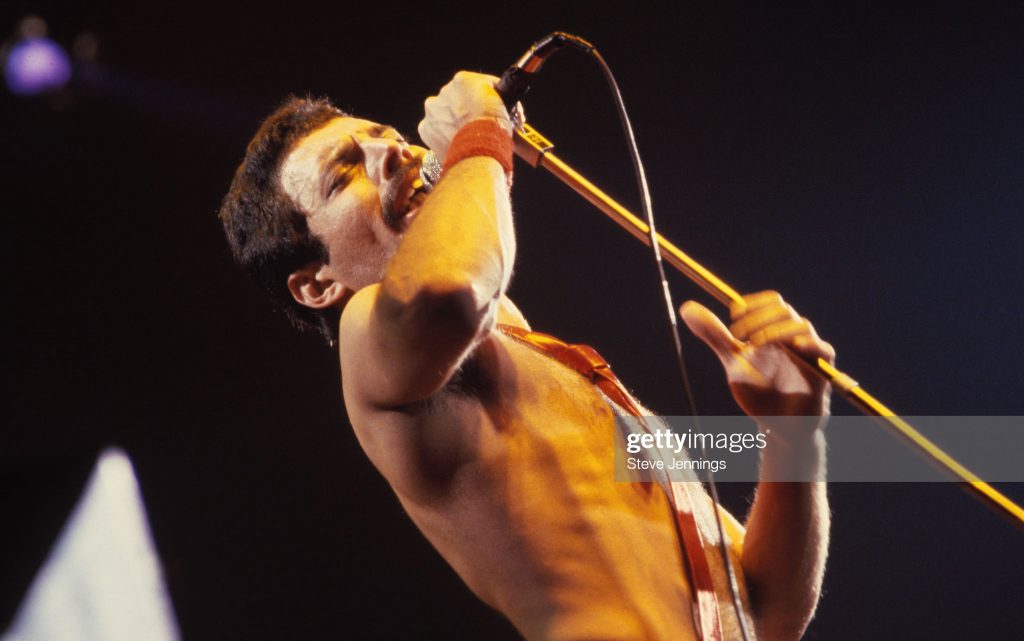
Freddie Mercury performing on “Jazz Tour 1980”, 19.04.1982. Photo by Steve Jennings.
A Sharp Perfectionism
Freddie Mercury is not only a legend because of his incredible and strong voice, but of his sharp perfectionism in his music and stage performances which earned him the respect of the famous musicians of his time and the next generations as well as the audience. He is a real talent that the Beatles’ stars Paul McCartney called “King Mercury” and Ringo Star “Your Highness”, that David Bowie and the legendary Led Zeppelin’s lead singer Robert Plant praised as a musician who went far beyond the concept of performance, and that Elton John highlighted as no one could sing like him.3
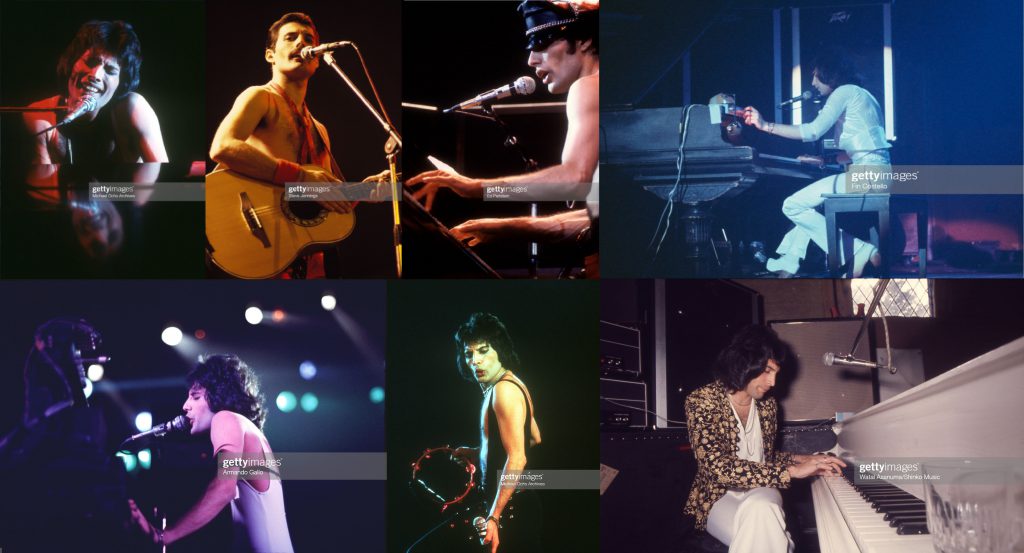
Freddie Mercury playing different instruments in concerts and rehearsals. Photos by (Top, from left to right): 1) Michael Ochs Archives, Inglewood, California, USA, 22.12.1977. 2) Steve Jennings, “Jazz Tour 1980”, 19.04.1982. 3) Ed Perlstein, Oakland, California, USA, 16.12.1978. 4) Fin Costello, 1975. Photos by (Bottom, from left to right): 1) Armando Gallo, Inglewood California, USA, 03.03.1977. 2) Michael Ochs Archives, Inglewood, California, USA, 22.12.1977. 3) Watal Asanuma/Shinko Music, Ridge Farm Studios, Sussex, England, 14.07.1975.
One of his friends and a musician Dave Clark explains in an interview, that they participated together, how a perfectionist Freddie Mercury was emphasizing that among the musicians he worked with, Freddie was the only one who was taking every rehearsal seriously as if he was performing at the stage before the audience.4
Montserrat Caballé, on the other hand, a famous Spanish opera artist whom Freddie Mercury admired and worked with for his last solo project “Barcelona”, an opera album, says “I have never heard, before or since, a singer with such a vocal range as Freddie… Barcelona was an example of the high musical talent of Freddie. He was not only a popular singer, he was a musician that could sit at the piano and compose. He discovered a new way to bring different music styles together. He is the first and only person to have done this.”5

Freddie Mercury and Monserrat Caballé performing “Barcelona” at KU club, Ibiza, Spain, 29.05.1987. Photo by FG/Bauer-Griffin.
Considered one of the most skilled singers and guitarists in the world, Prince, as well, was modest enough to begin his performance at Super Bowl in 2007, which was chosen as the best halftime show by the Rolling Stones magazine, with one of the most famous Queen songs, “We Will Rock You”.6
Again, Green Day, one of the most important punk rock bands of our time, was excited enough to share the enthusiasm of the enormous crowd singing “Bohemian Rhapsody”, one of Freddie Mercury’s most famous compositions, while waiting for them to take the stage in their 2017 concert.7
Freddie Mercury, as well, has been very clear about this perfectionism, which is praised and carried to the present day with enthusiasm by various artists. He describes in an interview how he is very hard with himself, uncompromising enough to discard a song if it doesn’t feel quite right to him. He admits that he is intricate and delicate which can be observed in his paintings. In this sense, he emphasizes that he loves particular artists like Richard Dadd, Alphonse Mucha, Salvador Dali, and Arthur Rackham.8
Freddie Mercury performing at World Forum, The Hague, Netherlands, 08.12.1974. Photo by Gijsbert Hanekroot. Links: Left, Middle, Right.
The Freddie Mercury Magic at Live Aid
When it comes to Live Aid in 1985, which is accepted as one of the most important rock events in the world,9 it is almost inevitable to first think of Freddie Mercury, and Queen’s Live Aid performance is still considered as one of the best live rock performances of all time, although 36 years have passed.10
Regarding that, Queen’s guitarist Brian May admits that they achieved this success entirely thanks to Freddie Mercury, and emphasizes that everyone played well that day but Freddie took it to a whole new level.11 Moreover, he also refers to Freddie as their secret weapon and an artist who can easily reach each and every audience in the stadium.12
Dave Grohl, on the other hand, the drummer of Nirvana and co-founder of Foo Fighters, remarks that Queen’s Live Aid performance should be studied like a lesson by every music band, considers Freddie Mercury as a genius in his relationship with the audience at Live Aid and pays his respect by calling him the best group leader ever.13
Freddie Mercury performing at Wembley Stadium during the Live Aid concert, London, England, 13.07.1985. Photos by: (Top left) Mirrorpix, (Top middle) Popperfoto, (Top right) Mirrorpix, (Bottom left) Pete Still, (Bottom middle) Neil Leifer, (Bottom left) Duncan Raban, (Rightmost) PA Images.
A Life Far Away From Public Eyes
Despite all this magnificent and extrovert power of artistic expression, Freddie Mercury prefers a secluded off-stage life. This choice is strong enough to want his ashes to remain hidden.14 Making candid statements in one of his interviews, Freddie Mercury mentions that he does not want to give people an idea about who he is and to build a frame around himself by saying this is me. He wants to leave it to people’s interpretations. While he believes it is very appealing not knowing the truth about someone, he also wants the audience to know that what he does is his character and that there is no room for falsity on stage.15 He expresses that he is a very different person on and off stage as such: “I’m so powerful on stage I seem to have created a monster. When I’m performing I’m an extrovert yet inside I’m a completely different man.”16
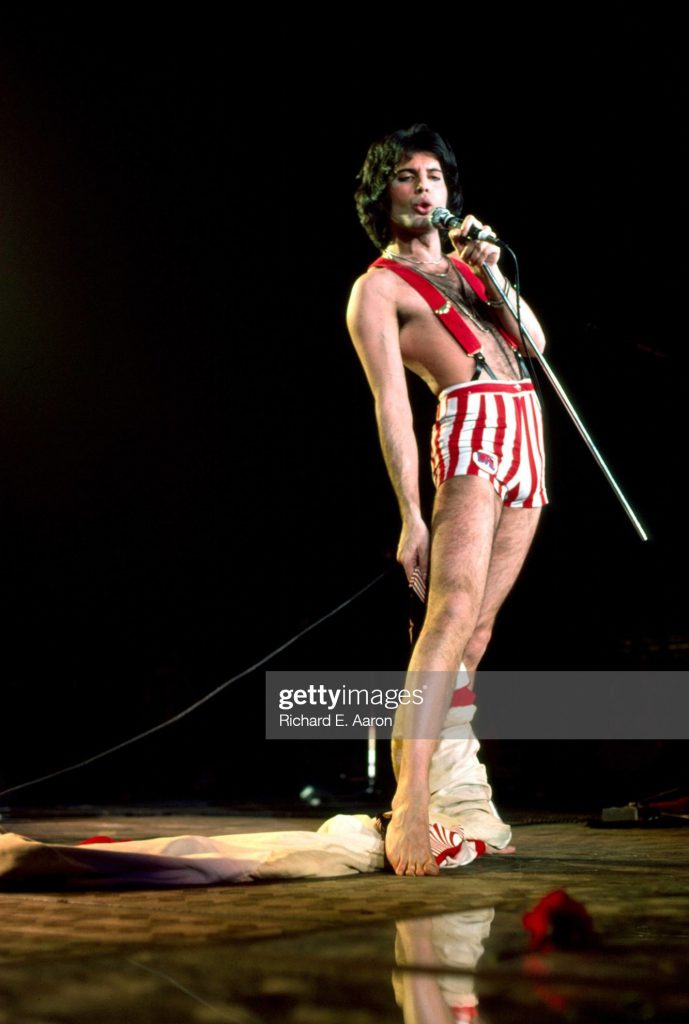
Freddie Mercury performing at Madison Square Garden, USA, 01.01.1977. Photo by Richard E. Aaron.
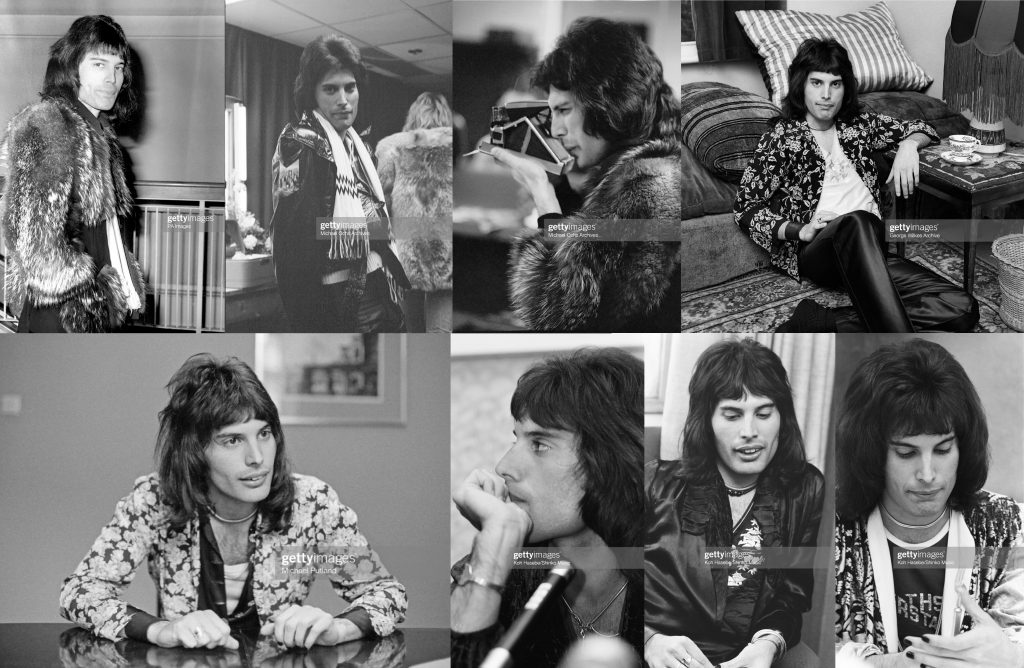
Freddie Mercury off stage in the 70s. Photos by (Top, from left to right): 1) PA Images, Heathrow Airport, London, England, 20.01.1976. 2) Michael Ochs Archives, 1977. 3) Michael Ochs Archives, Los Angeles, USA, 1977. 4) George Wilkes Archive, August, 1973. Photos by (Bottom, from left to right): 1) Michael Putland, 12.02.1974. 2) Koh Hasebe/Shinko Music, 18.04.1975. 3) Koh Hasebe/Shinko Music, London, England, 13.06.1974. 4) Koh Hasebe/Shinko Music, Tokyo, Japan, 21.03.1976.
In the meantime, Freddie Mercury states that the stage contributes a lot to him, that he always learns something new after each concert, and that he always works to be able to do something new.17 Accordingly, those who know him closely always mention candidly how humble and thoughtful he was. For example, Roger Taylor, the drummer of Queen and a close friend of Freddie Mercury even before the band, tells: “No-one really knew Freddie. He was shy, gentle, and kind. He wasn’t the person he put over on stage.”18
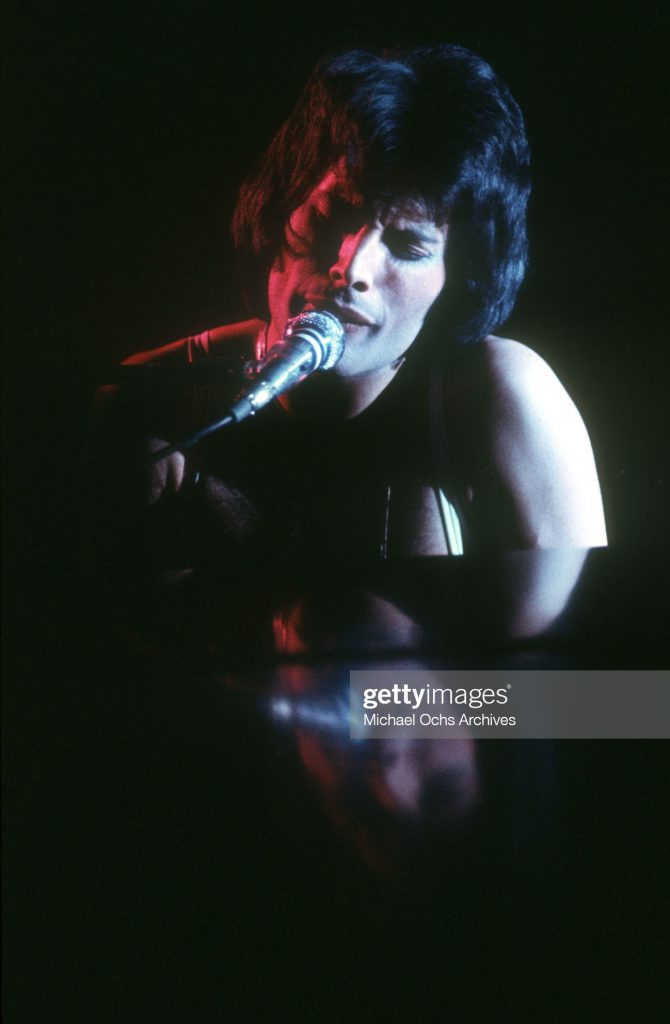
Freddie Mercury performing at the Forum, Inglewood, California, USA, 22.12.1977. Photo by Michael Ochs Archives.
It is not surprising that the logo designed by such an impressive yet introverted personality is as magnificent and at the same time mysterious as the person who designed it.
The Queen Logo

Two years before Queen was formed, Freddie Mercury graduated with a degree in graphic design in 1969 from Ealing Art College, which is now a part of the University of West London. The year after his graduation, he joined Smile, the former band of guitarist Brian May and drummer Roger Taylor, which also provided the basis for Queen. In 1971, with the participation of the bass guitarist John Deacon and after the name of the band was changed to Queen by Freddie Mercury, the formation process of the band that we know as Queen today was completed. From then on, Queen began to leave its mark in music history without changing its members until Freddie Mercury’s death in 1991.
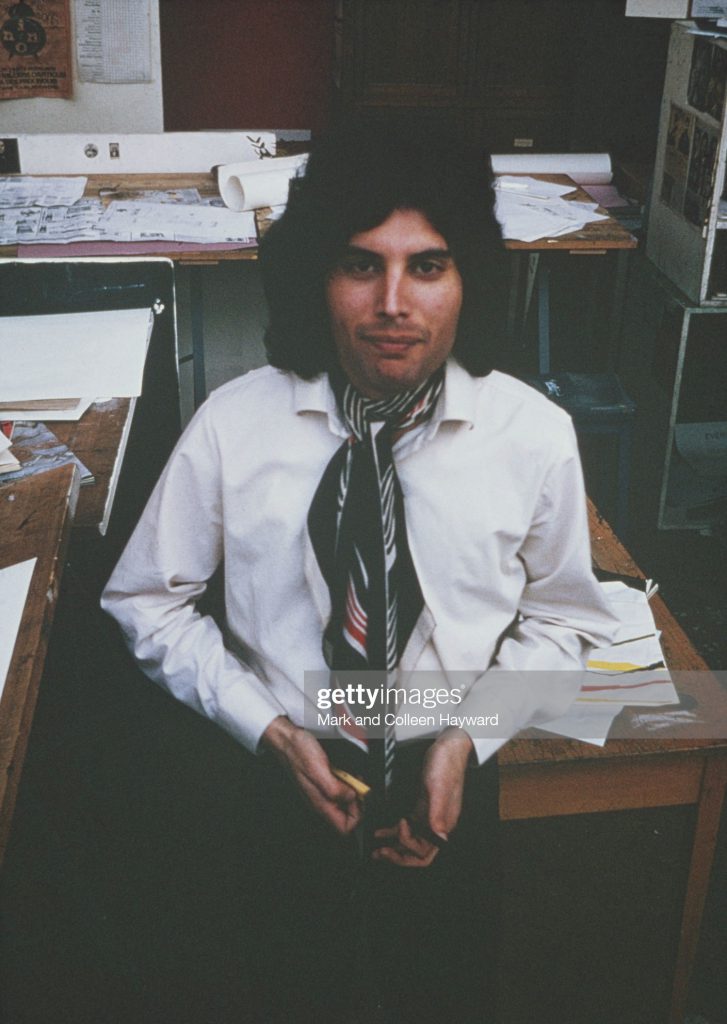
Freddie Mercury at Ealing Art College, London, 1969. Photo by Mark and Colleen Hayward.
After the formation of Queen, its logo was designed by Freddie Mercury at the same time as their 1973 debut album “Queen”. The logo was finalized in 1975, after Freddie Mercury redesigned it with details and also after the Queen font was added at the bottom.
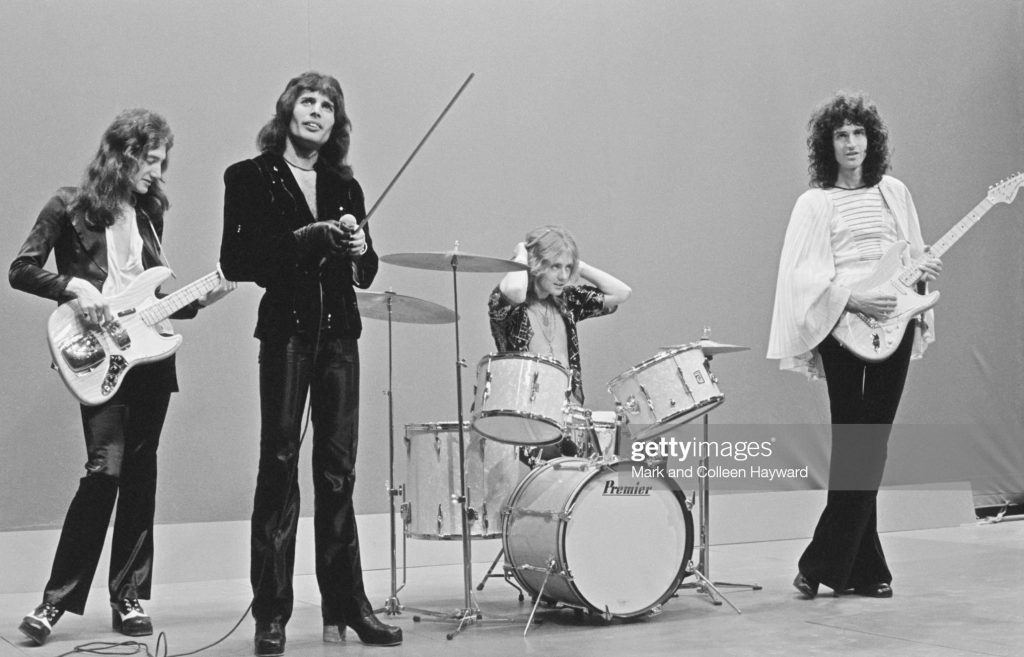
Queen performing on the Dutch TV show TopPop, 22.11.1974. Photo by Mark and Colleen Hayward.
Balance and Sincerity
When looking at the Queen logo, colorful, and impressive as much as Freddie Mercury himself, two contrasting yet harmonious elements draw attention at first sight: A formal classical balance and a transformative original sincerity.
First of all, about the detailed figures, the striking five of them reflect the zodiac signs of the group members: Two lions (Leo) for John Deacon and Roger Taylor, the crab (Cancer) for Brian May, and two maidens (Virgo) for Freddie Mercury. All the figures are lined up around the letter Q with a crown in the middle of it, as if they are holding on, hugging, and watching it. Above all, a phoenix rises from the flames, taking all the other figures under its wing, as if protecting them. The subtle arrangement of the figures around the first letter of Queen almost reveals the balanced harmony in the strong composition tradition that remained from the High Renaissance.
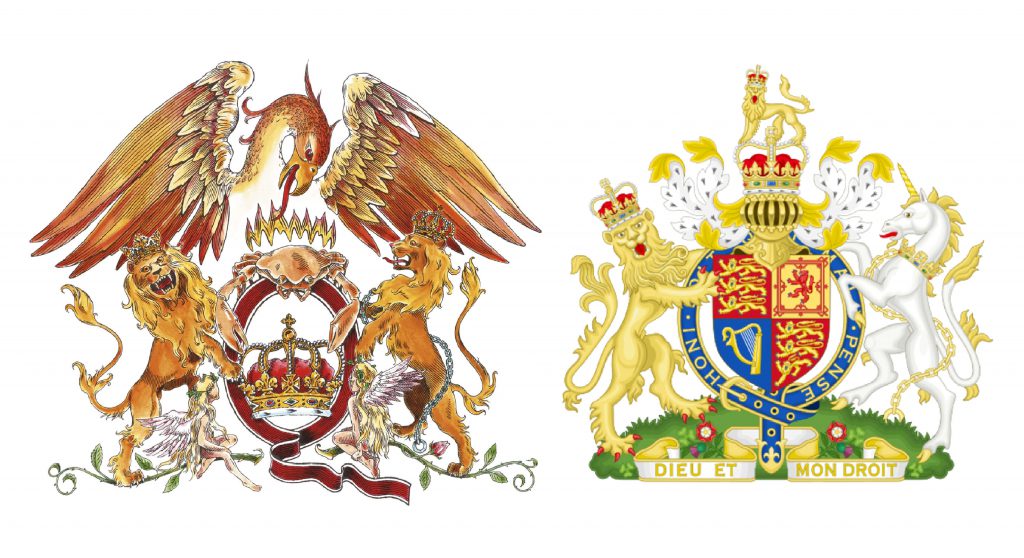
The Queen Logo and the United Kingdom Coat of Arms
Based on the royal coat of arms of the United Kingdom, on the other hand, the Queen logo, also known as the Queen Crest, adds a new twist to this classic image. In this sense, creating a break in the seriousness of the royal crest, Freddie Mercury turns it in a more personal direction. Maybe he looks for sincerity in the old, like the Pre-Raphaelites, who are from England as well, opposing and reinterpreting the artistic understanding of the period. At this point, Freddie Mercury finds that sincerity by embroidering the individuality and uniqueness of each group member into the logo with the representation of their zodiac signs.
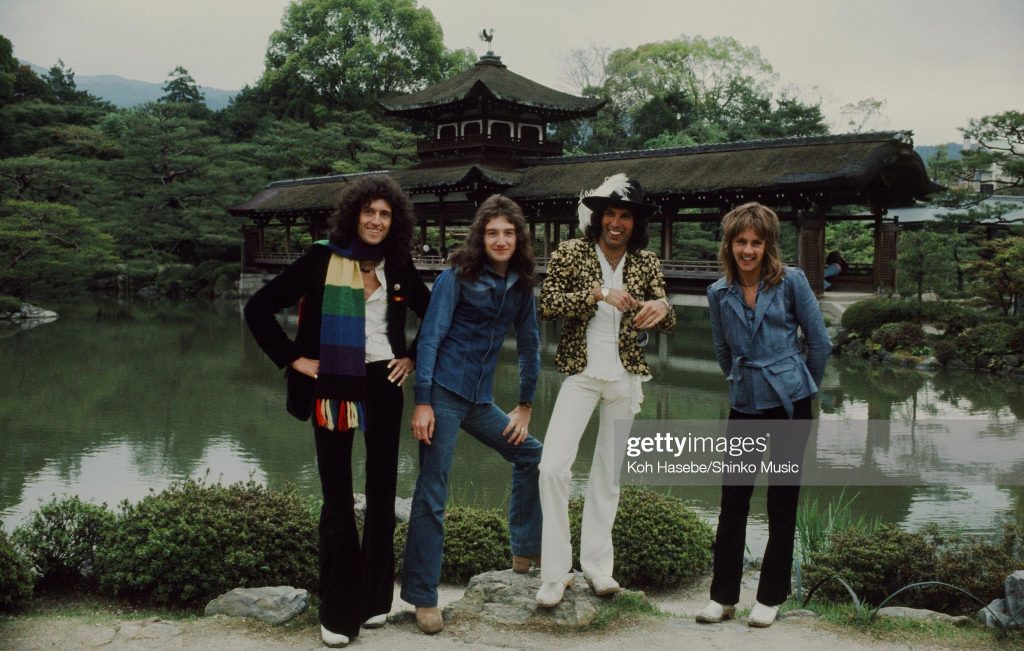
Queen in Kyoto, Japan, 22.04.1975. Photo by Koh Hasebe/Shinko Music.
A Transformative Musical Power
The Queen logo, in the meantime, points to the transformative influence of Queen in music history, almost like Cezanne did for art history. By achieving balance and perfection of Poussin with his own methods, Cezanne guided art history to an extent that inspired Cubism. At this point, Freddie Mercury seems like revealing how the creativity inherent in each band member, who also separately has written their names to the music history, become a power when coming together and getting integrated. In this sense, the logo almost refers to the pure professionalism of the band members while making music together. The powerful music born of this togetherness is embodied exactly in the most eye-catching figure of the logo, the phoenix, the symbol of immortality. Just like this phoenix, Queen’s music is also gigantic, endless, majestic, and passionate.

Freddie Mercury performing on the “Magic Tour” at Wembley Stadium in London, England, 11-12.07.1986. Photo by Denis O’Regan.
From this perspective, even solely “Bohemian Rhapsody”, a Freddie Mercury composition strikingly reflecting Queen’s originality with its arrangement which makes it one of the most famous songs in music history, can be concrete proof of this influence.
After all, just as Cezanne did not particularly aim to leave his mark on art history but to look for answers to the artistic problems he was dealing with in his solitude,19 Freddie Mercury, as well, highlights that he does not want to change the world with their music but just to make it.20
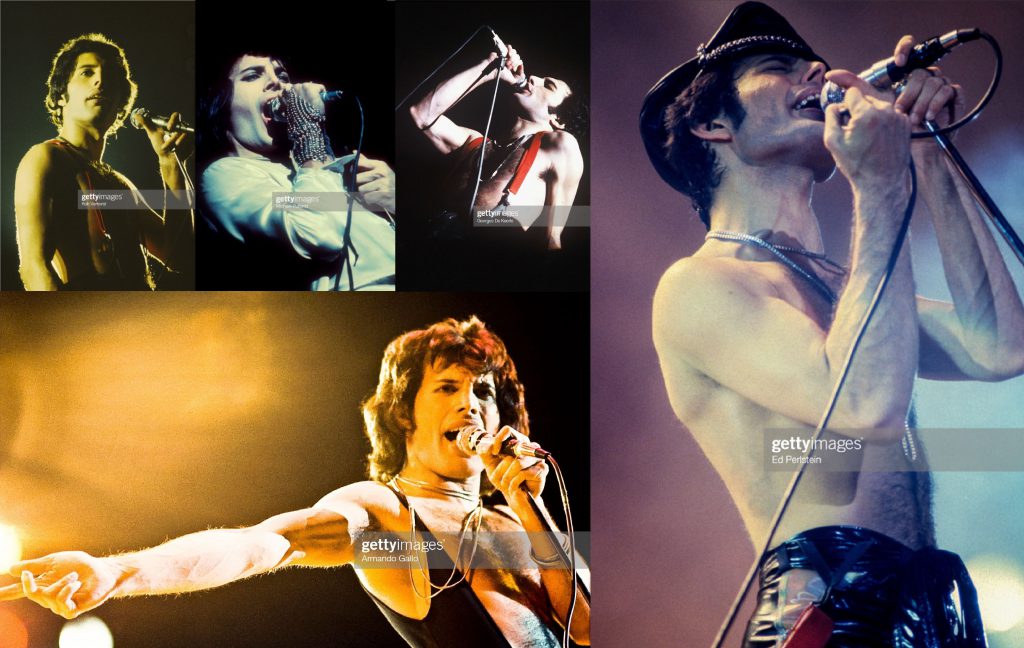
Freddie Mercury on stage in the 70s. Photos by: (Top left) Rob Verhorst, 29.01.1979. (Top middle) Michael Putland, 1975. (Top right) Georges De Keerle, Paris, France, June, 1979. (Bottom) Armando Gallo, Inglewood, California, USA, 03.03.1977. (Rightmost) Ed Perlstein, Oakland, California, USA, 16.12.1978.
Perfectionism and professionalism, however, inevitably lead to this result, and that transformative musical power, which can be referred to as Queen originality and freedom, continues to affect the music world for years, just like Cezanne’s impact on art history.
The Freddie Mercury Effect
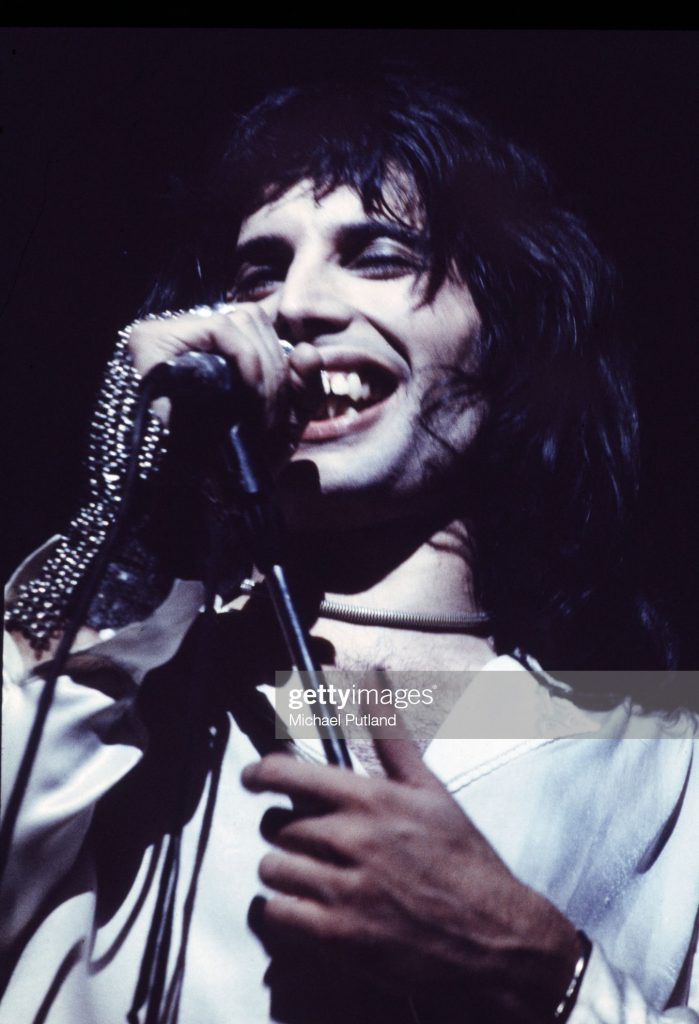
Freddie Mercury on stage at a Queen Concert, 1974. Photo by Michael Putland.
Freddie Mercury is a star who still fascinates the whole world with his creative music, even years after his passing. He is a legend who continues to give us the shivers with his never-ending energy and command on stage,21 his mastery at the piano,22 his stage costumes mostly designed by himself for concerts,23 his sincere dialogue with the audience,24 his power to direct the audience as a single body,25 and of course his excellent voice and compositions.26
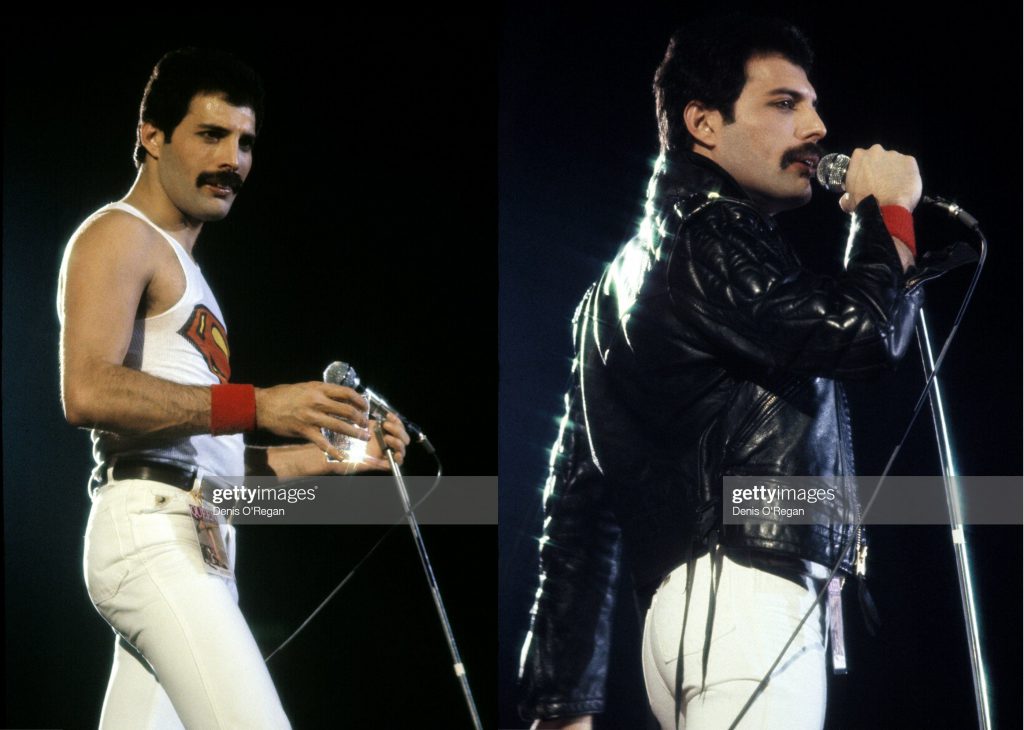
Freddie Mercury performing at Wembley Arena in London, England, 1984. Photos by Denis O’Regan. Links: Left, Right.
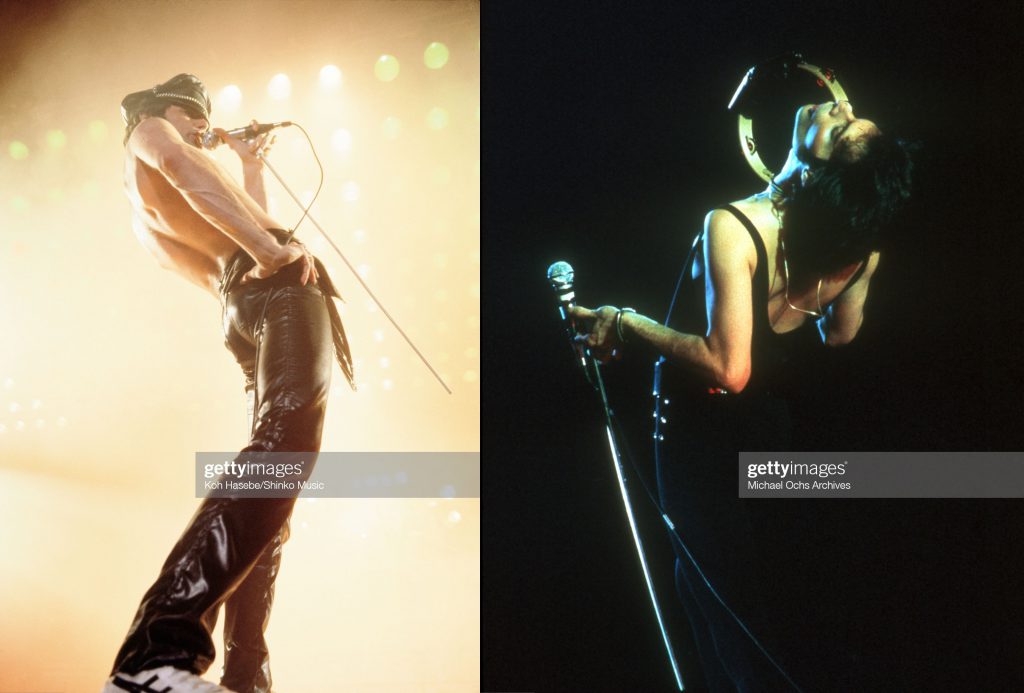
(Left) Freddie Mercury performing on the “Jazz” tour at Budokan in Tokyo, Japan, April, 1979. Photo by Koh Hasebe. (Right) Freddie Mercury performing at the Forum in Inglewood, California, USA, 22.12.1977. Photo by Michael Ochs Archives.
After Freddie Mercury passed away on the 24th of November in 1991, Queen continued on its way with Brian May and Roger Taylor. They give their concerts as “Queen +” hosting different singers for a certain period of time.27 While the legendary British rock group Led Zeppelin disbanded at their peak after their drummer John Bonham passed away in 1980, saying that they could not replace him, Queen’s choice after an impressive vocalist like Freddie Mercury can be arguable of course.
Fortunately, it can be seen that these singers have undertaken the task of transmitting the legend of Freddie Mercury to new generations through his songs. On the other hand, it is really hard to deny how beautiful it is to see even video footage of Freddie Mercury appearing on stage and the emotional impact of this appearance while Brian May sings alone at new Queen concerts one of the most touching Freddie Mercury songs, “Love of My Love”.28
Eventually, it is a fact that it is always Freddie Mercury that is spoken of at the end of the day. As John Deacon, the bass guitarist of Queen and close friend, who was very affected by Freddie Mercury’s death and quited music, once said: “It is impossible to replace Freddie.”29
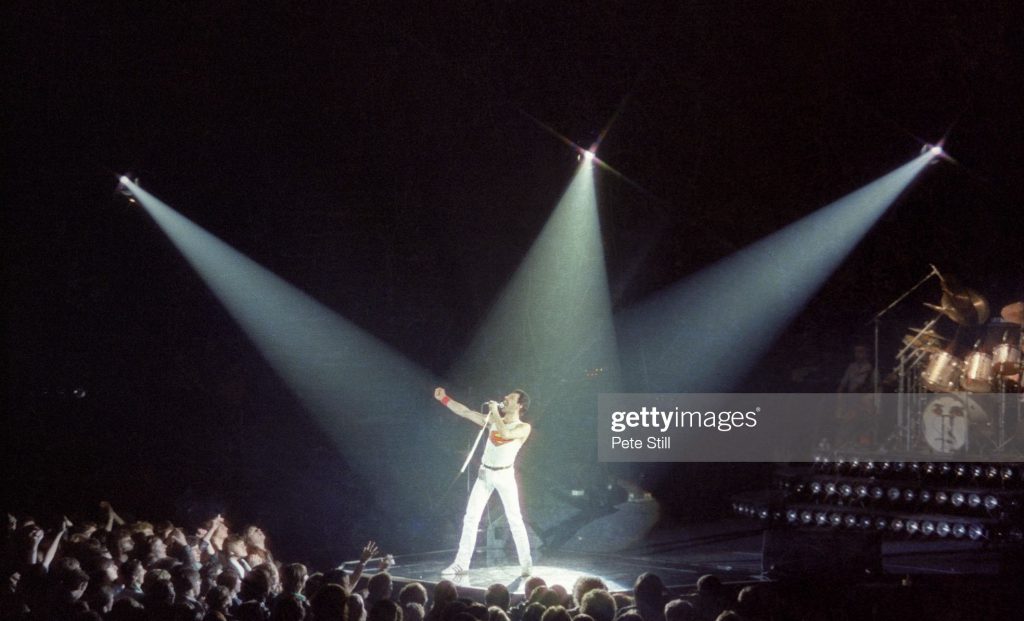
Freddie Mercury, performing at Wembley Arena, London, England, 10.12.1980. Photo by Pete Still.
Conclusion
As a group that has found its own identity by integrating the talent, professionalism, and personality of each member, Queen is still a part of our lives with its songs that are as exciting as the first day even after listening again and again. But it is an irresistible fact that Freddie Mercury, solely, goes beyond Queen and he is the first name that comes to mind when Queen is mentioned.
Freddie Mercury continues to amaze the whole world from ordinary listeners to professional musicians with his voice, sometimes as soft and bright as fresh snow, sometimes as strong as a stormy sea, sometimes as fun as a game, and sometimes as hard and powerful as you hear when you running your hand through the boxwoods leaf.
As a result, it is not a coincidence that this logo, which became the symbol of Queen, was designed by an artist like Freddie Mercury, sensitive yet creative, versatile, and insistent on the balance and perfection he achieved in his art. Only such talent could reveal both a classic, calm seriousness and sharp, transformative and original sincerity at the same time.
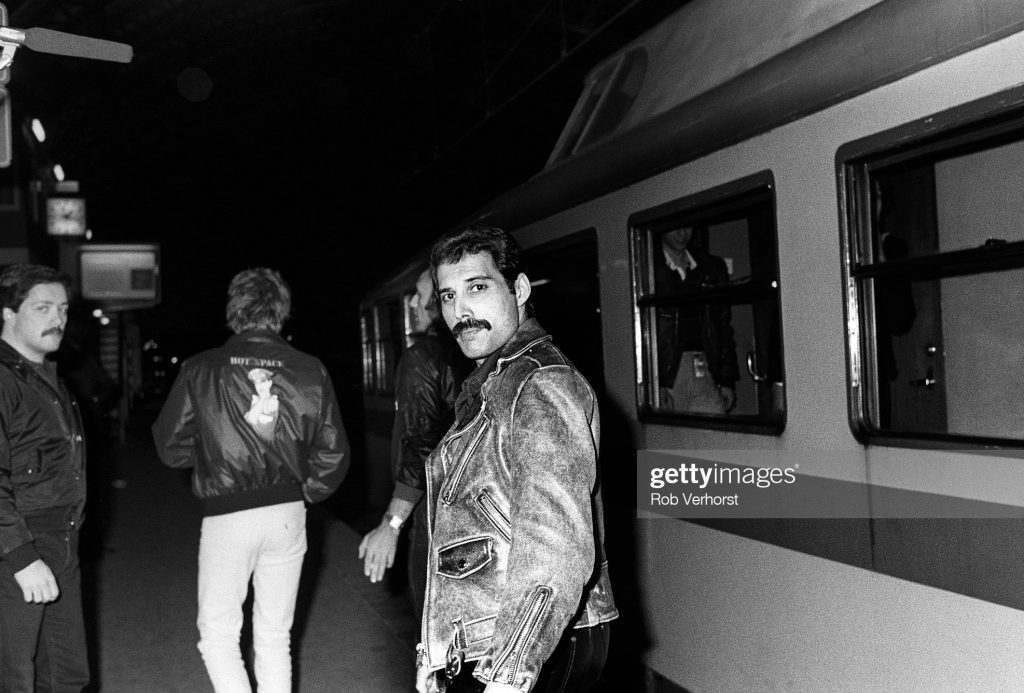
Freddie Mercury, heading to Amsterdam by train after a gig in Leiden, Netherlands. 25.04.1982. Photo by Rob Verhorst.
References and Notes
1. Caroline Sullivan. (27.09.2012). Freddie Mercury: the great enigma. The Guardian. Date accessed: 12.09.2021.
2. Christian T. Herbst, Stellan Hertegard, Daniel Zangger-Borch, Per-Åke Lindestad. (12.02.2016). Freddie Mercury – acoustic analysis of speaking fundamental frequency, vibrato, and subharmonics. Logopedics Phoniatrics Vocology, Volume: 42, Issue: 1. Date accessed: 02.09.2021.
3. Click here for quotes about Freddie Mercury. Date accessed: 01.09.2021.
4. Click here to watch the interview with Freddie Mercury ve Dave Clark. Date accessed: 22.10.2021.

Freddie Mercury performing on the “Sheer Heart Attack” tour at Rainbow Theatre, London, England, 19.11.1974. Photos by Ian Dickson. Links: Left, Right.
5. Click here for the solo album archives of Freddie Mercury. Date accessed: 08.09.2021.
6. Rob Sheffield. (04.02.2021). Super Bowl Halftime Shows Ranked: From Worst to Best. Rolling Stone. Date accessed: 01.09.2021.
7. The aforementioned Green Day Concert was held at Hyde Park, London on July 1, 2017, as a part of the British Summer Time Festival. The behind scene video of the huge crowd singing Bohemian Rhapsody together while waiting for the band to take the stage is posted on Green Day’s YouTube channel. Click here to watch the video. Date accessed: 08.09.2021.
8. Caroline Coon. (22.11.2011). ‘I can dream up all kinds of things’ – a classic Freddie Mercury interview from the vaults. The Guardian. Date accessed: 01.09.2021
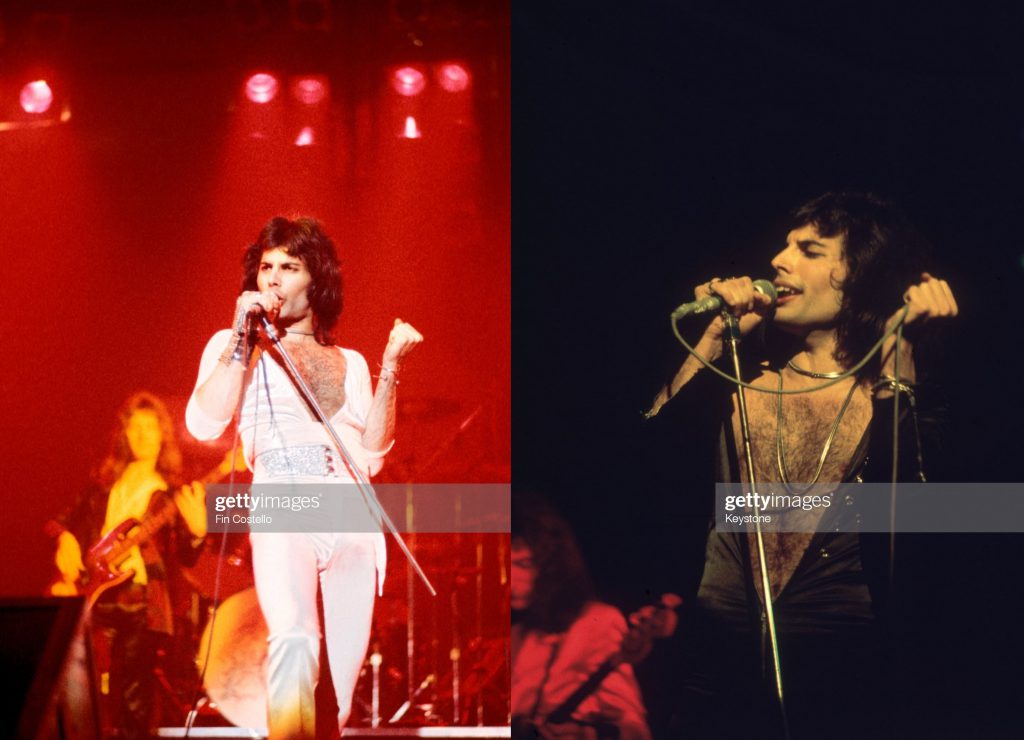
(Left) Freddie Mercury performing at a Queen concert, February, 1975. Photo by Fin Costello. (Right) Freddie Mercury performing during Queen’s British tour, 1975. Photo by Keystone.
9. Live Aid was a worldwide benefit concert to raise money for famine relief in Ethiopia. It was held simultaneously at Wembley Stadium in London and John F. Kennedy Stadium in Philadelphia on July 13, 1985. Bob Geldorf, the organizer of the event, was knighted by Queen Elizabeth II for his efforts to draw the attention of the West to Africa.
- Click here for more information about Live Aid. Date accessed: 09.09.2021.
- Click here for more information about the participant artists and program schedule. Date accessed: 09.09.2021.
Also, see:
- Michael Ray. Live Aid. Britannica. Date accessed: 09.09.2021.
- Michael Goldberg. (16.08.1985). Live Aid 1985: The Day the World Rocked. Rolling Stone. Date accessed: 24.09.2021.
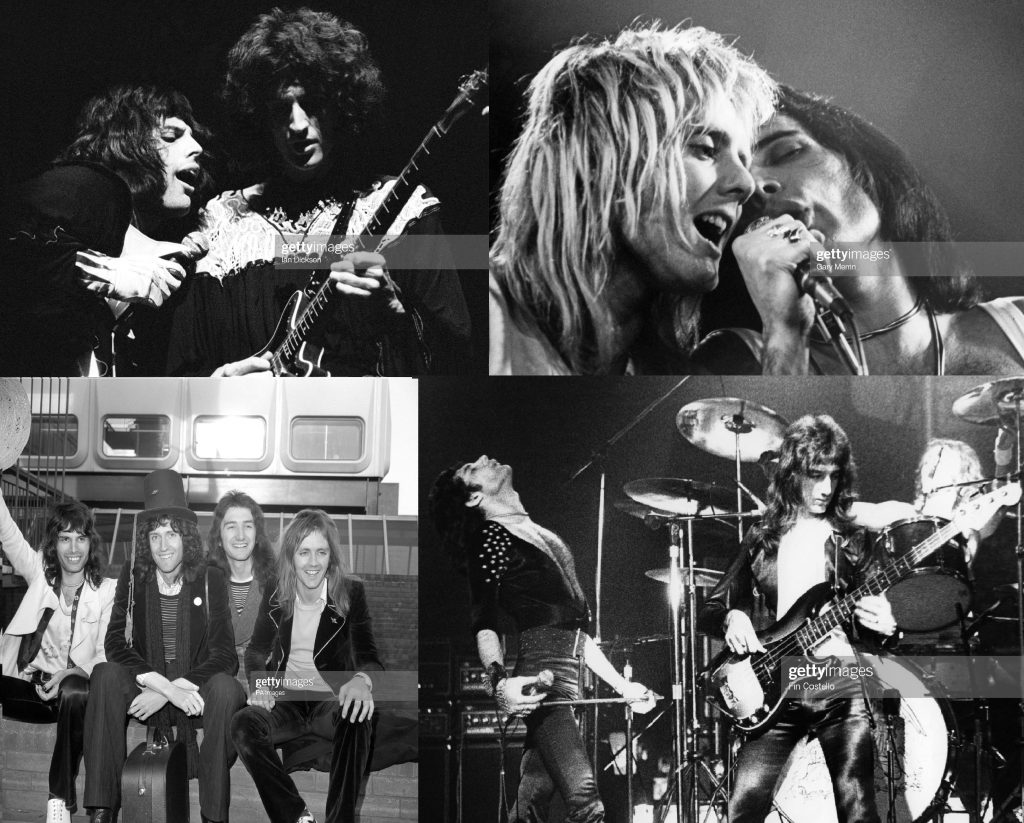
(Top left) Freddie Mercury with the guitarist Brian May on stage, 1974. Photo by Ian Dickson. (Top right) Freddie Mercury with the drummer Roger Taylor on stage at the Playhouse, Edinburgh, Scotland, 01.09.1976. Photo by Gary Merrin. (Bottom left) Queen arrives back from their tour of Australia, 31.01.1974 Photo by PA Images. (Bottom right) Freddie Mercury and the bass player John Deacon on stage, 1975. Photo by Fin Costello.
10. At Live Aid, where such huge names as Elton John, Paul McCartney, Phil Collins, David Bowie, Madonna, Eric Clapton, and Tina Turner took the stage, Queen’s 20-minute performance is considered one of the most important live rock performances in history.
- Click here to watch Queen’s Live Aid performance. Date accessed: 01.09.2021.
Also, see:
- BBC News. (09.11.2005). Queen win greatest live gig poll. BBC. Date accessed: 01.09.2021.
- Andy Greene. (05.02.2013). Flashback: Queen Steal the Show at Live Aid. Rolling Stone. Date accessed: 01.09.2021.
- Holly Thomas. 33 years later, Queen’s Live Aid performance is still pure magic. CNN. Date accessed: 01.09.2021.
- Martin Chilton, (13.07.2019). Queen’s Live Aid Performance: How Rock’s Royalty Stole The Show. U Discover Music. Date accessed: 24.09.2021.
11. Nick DeRiso. (13.07.2020). How Queen Stole the Show at Live Aid. Ultimate Classic Rock. Date accessed: 24.09.2021.
12. Mark Beaumont. (11.07.2020). Aaaaaay-o! Aaaaaay-o! Why Live Aid was the greatest show of all. Independent. Date accessed: 24.09.2021.
13. James Brinsford. (16.01.2020). How Freddie Mercury’s ‘trick’ won over Live Aid crowd was ‘genius’. Mirror. Date accessed: 24.09.2021.
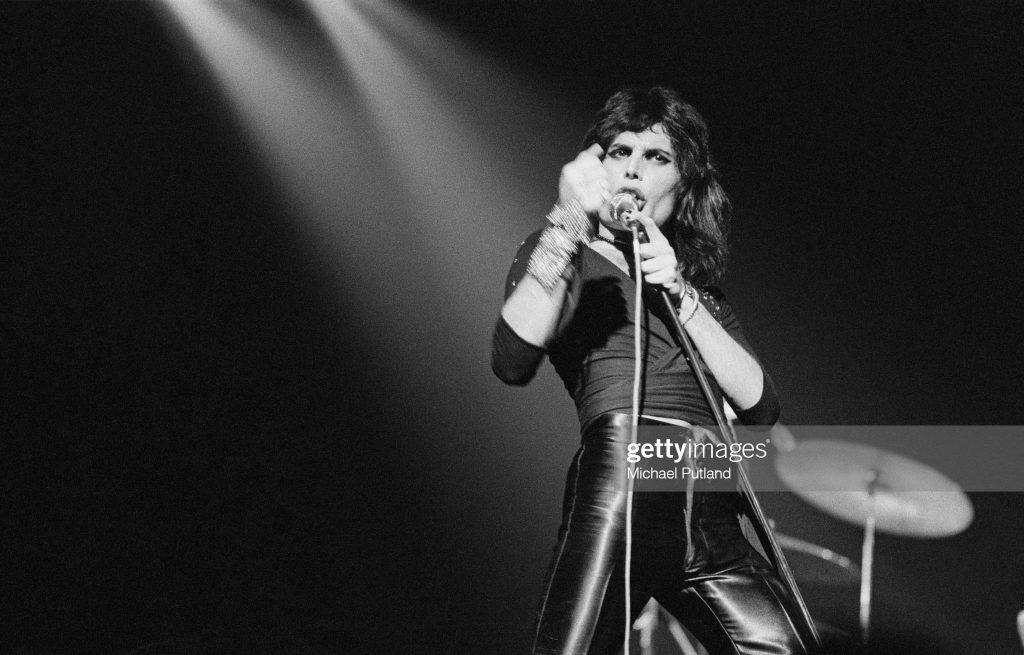
Freddie Mercury performing at a Queen concert, 1974. Photo by Michael Putland.
14. No one still knows the whereabouts of Freddie Mercury’s ashes except, at his own request, his ex-fiancee and friend Mary Austin. See: Jane Lavender, James Brinsford. (13.07.2020). Freddie Mercury’s ashes buried in secret. Mirror. Date accessed: 02.09.2021. Also see: David Wigg. (30.03.2013). I was cursed by Freddie’s fortune. Daily Mail. Date accessed: 18.11.2021.
15. Click here for quotes by Freddie Mercury. Date accessed: 01.09.2021
16. Caroline Coon. (22.11.2011). ‘I can dream up all kinds of things’ – a classic Freddie Mercury interview from the vaults. The Guardian. Date accessed: 01.09.2021.
17. Click here to watch the interview with Freddie Mercury in 1982. Date accessed: 01.10.2021.
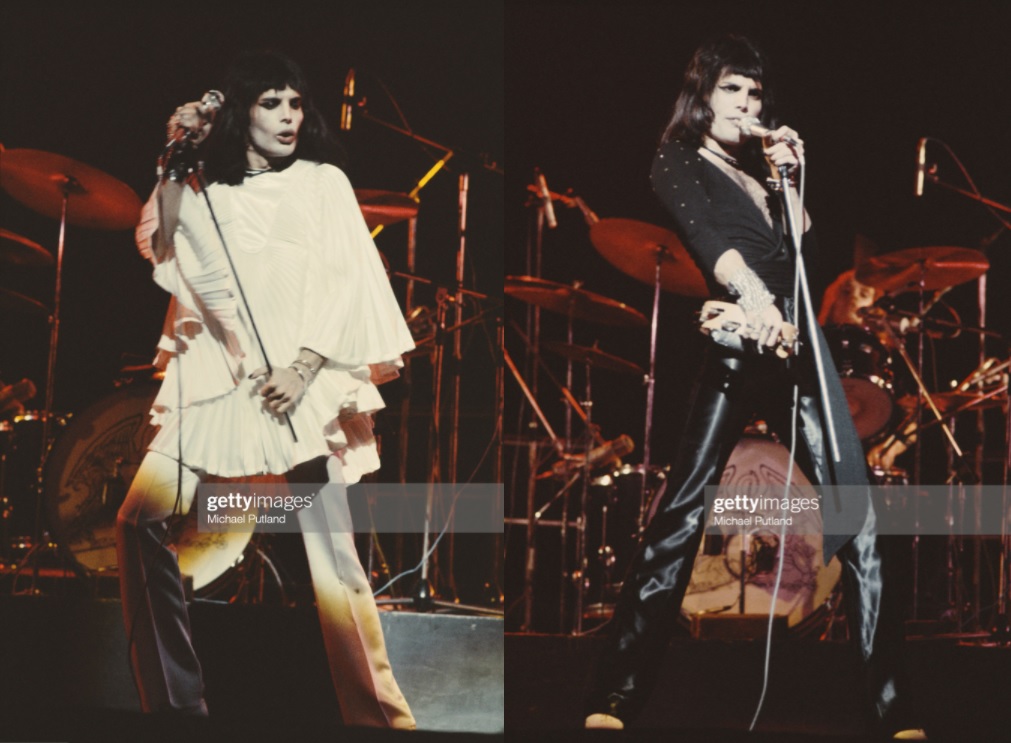
(Left) Freddie Mercury performing at a Queen concert, London, England, 1974. Photo by Michael Putland. (Right) Freddie Mercury performing on the “Sheer Heart Attack” tour at the Rainbow Theatre, London, England, 20.11.1974. Photo by Michael Putland.
17. Click here to watch the interview with Freddie Mercury in 1982. Date accessed: 01.10.2021.
18. Click here for quotes about Freddie Mercury. Date accessed: 01.09.2021.
19. E.H. Gombrich. (2016). The Story of Art (Pocket ed. 1st Printing) (Translation: Erol Erduran, Ömer Erduran). İstanbul: Remzi Kitabevi.
20. Click here for quotes by Freddie Mercury. Date accessed: 01.09.2021.
21. As an impressive example of this, click here to watch Freddie Mercury live at Queen’s 1981 Montreal concert singing “Somebody to Love” written by him. Date accessed: 02.05.2021.
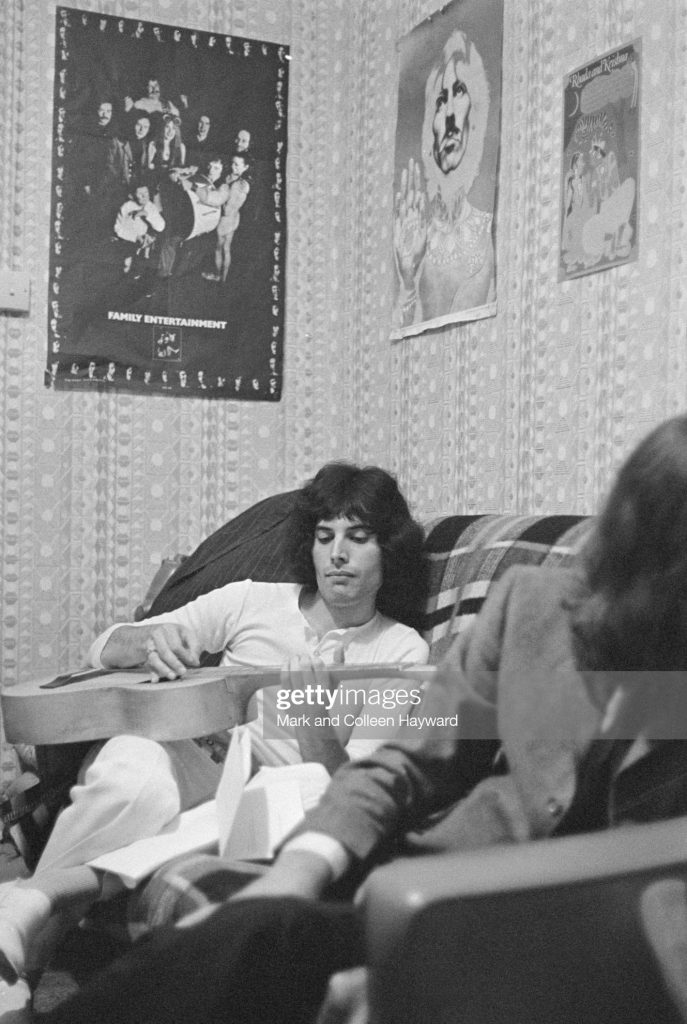
Freddie Mercury, during an interview with the Daily Express at his Shepherds Bush flat, London, England, 1969. Photo by Mark and Colleen Hayward.
22. As a powerful example of this, click here to watch Freddie Mercury live at Queen’s concert at Odeon Hammersmith, London in 1975, playing the piano while performing “White Queen” written by him. Date accessed: 02.05.2021. As another example, click here to watch Freddie Mercury performing live “You Take My Breath”, one of his most touching compositions. Date accessed: 08.06.2021.
23. For the Vogue article describing Freddie Mercury as a style icon and emphasizing the enduring influence of his fashion style, see: Jessica Bumpus. (18.10.1018). Style Icon: Freddie Mercury. Vogue. Date accessed: 09.09.2021. Regarding the importance Freddie Mercury attaches to stage costumes in his relationship with the audience, also see: Cynthia Green, (18.02.2019). Freddie Mercury, Addressing the Audience. The Voice of Fashion. Date accessed: 24.09.2021.
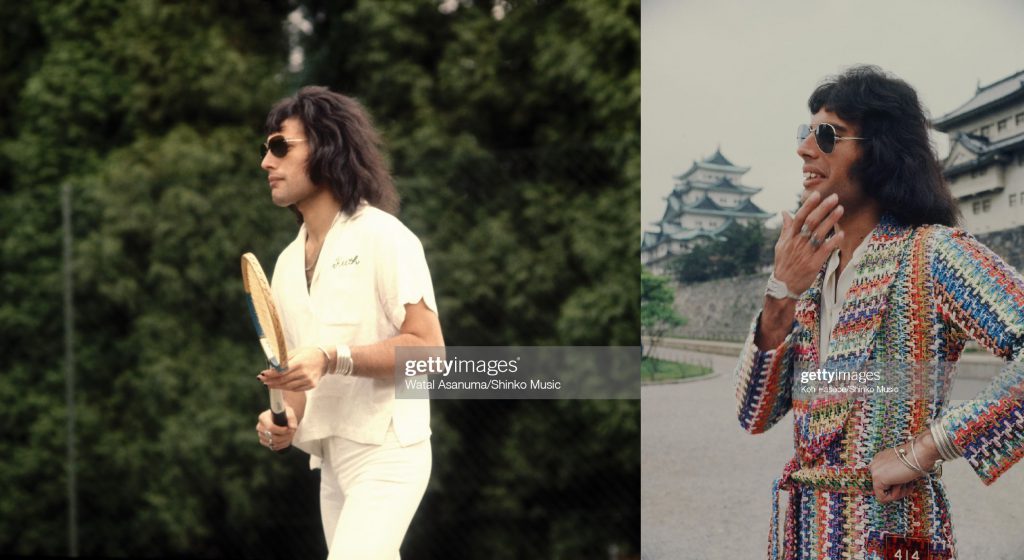
(Left) Freddie Mercury playing tennis at Ridge Farm Studio during the recording of their album “A Night At The Opera”’, Surrey, England, 14.07. 1975. Photo by Watal Asanuma/Shinko Music. (Right) Freddie Mercury, against the Nagoya Castle, Japan, 22.04.1975. Photo by Koh Hasebe/Shinko Music.
24. Kurt Cobain wrote in his suicide note that he admired and even envied Freddie Mercury’s relationship with the audience. Click here to read. Date accessed: 01.10.2021
25. As an example of this, click here to watch the part where Freddie Mercury directed the audience like a choirmaster with his famous “Ayo” performance at Queen’s 1985 Live Aid concert. Click here for the “Radio Gaga” performance from the same concert with a similar effect. Date accessed: 01.09.2021.
26. As an example of Freddie Mercury’s versatile voice, click here to listen to “Exercises in Free Love”, a version of “Ensueño” without lyrics. The song is composed by Freddie Mercury and Mike Moran and lyrics added by Montserrat Caballé in the Barcelona album. Date accessed: 08.09.2021. As another important example, despite his illness, Freddie Mercury recorded “Show Must Go On” in one take, one of the most famous and impressive yet hard to sing Queen songs composed by Brian May. See: George Simpson. (28.08.2020). Freddie Mercury’s ‘UNFORGETTABLE’ The Show Must Go On recording: Brian May on his tenacity. Express. Date accessed: 01.11.2021. Click here to listen to “Show Must Go On”. Date accessed: 08.07.2021.
27. Queen organized concerts in 2005 and 2008 in collaboration with Paul Rodgers. Since 2012, they have been performing with Adam Lambert.
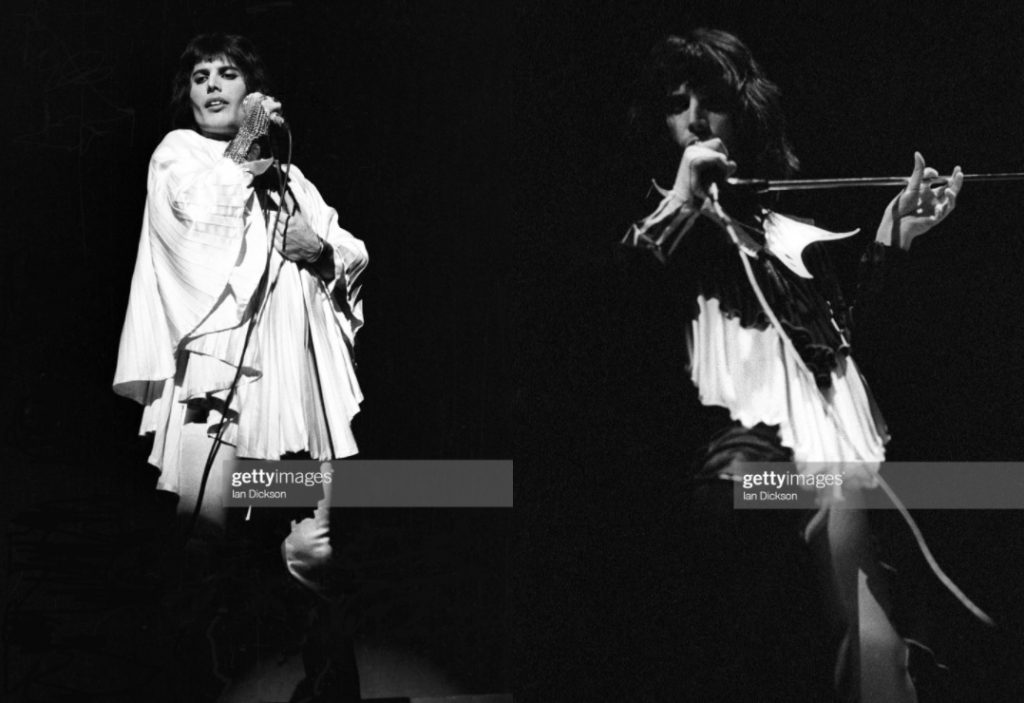
(Left) Freddie Mercury performing at a Queen concert, 1974. Photo by Ian Dickson. (Right) Freddie Mercury performing on the “Queen II” tour at Rainbow Theatre, London, England, 31.03.1974. Photo by Ian Dickson.
28. Freddie Mercury wrote the song “Love of My Life” for his ex-fiancee and friend Mary Austin. This song is from their fifth album “A Night at the Opera”, which also includes “Bohemian Rhapsody” that made Queen famous all over the world. The acoustic version of the song, in which Brian May accompanies Freddie Mercury with 12 string guitar, is an important example in terms of Freddie Mercury’s strong voice, his relationship with the audience and the reflection of the energy between them. So much so that in concerts, Freddie Mercury makes the audience sing most of the parts of the song. As an example, click here to watch the live performance at Queen’s 1986 Wembley concert. Date accessed: 08.09.2021. After the death of Freddie Mercury, Brian May continues to sing this song alone, and the image of Freddie Mercury at the end of the song gives emotional moments to both May and the audience. As an example, click here to watch Brian May’s live performance at Queen’s 2014 Tokyo concert. Date accessed: 08.09.2021.
29. Giorgina Hamilton. (15.09.2020). Queen: Watch John Deacon’s touching final message to fans before he quits the band. Smooth Radio. Date accessed: 23.09.2021.
30. Photos courtesy of Getty Images.

Freddie Mercury, performing at Slane Castle, Ireland, 1986. Photo by Denis O’Regan.
@bnkvisualarts, who made the poster and artwork, referenced the photo taken by Denis O’Regan at Queen’s 1986 UK concert.
Click here for “Freddie Mercury & Queen” Spotify list by Güncel Sanat Arşivi.
Click here for more translation.
